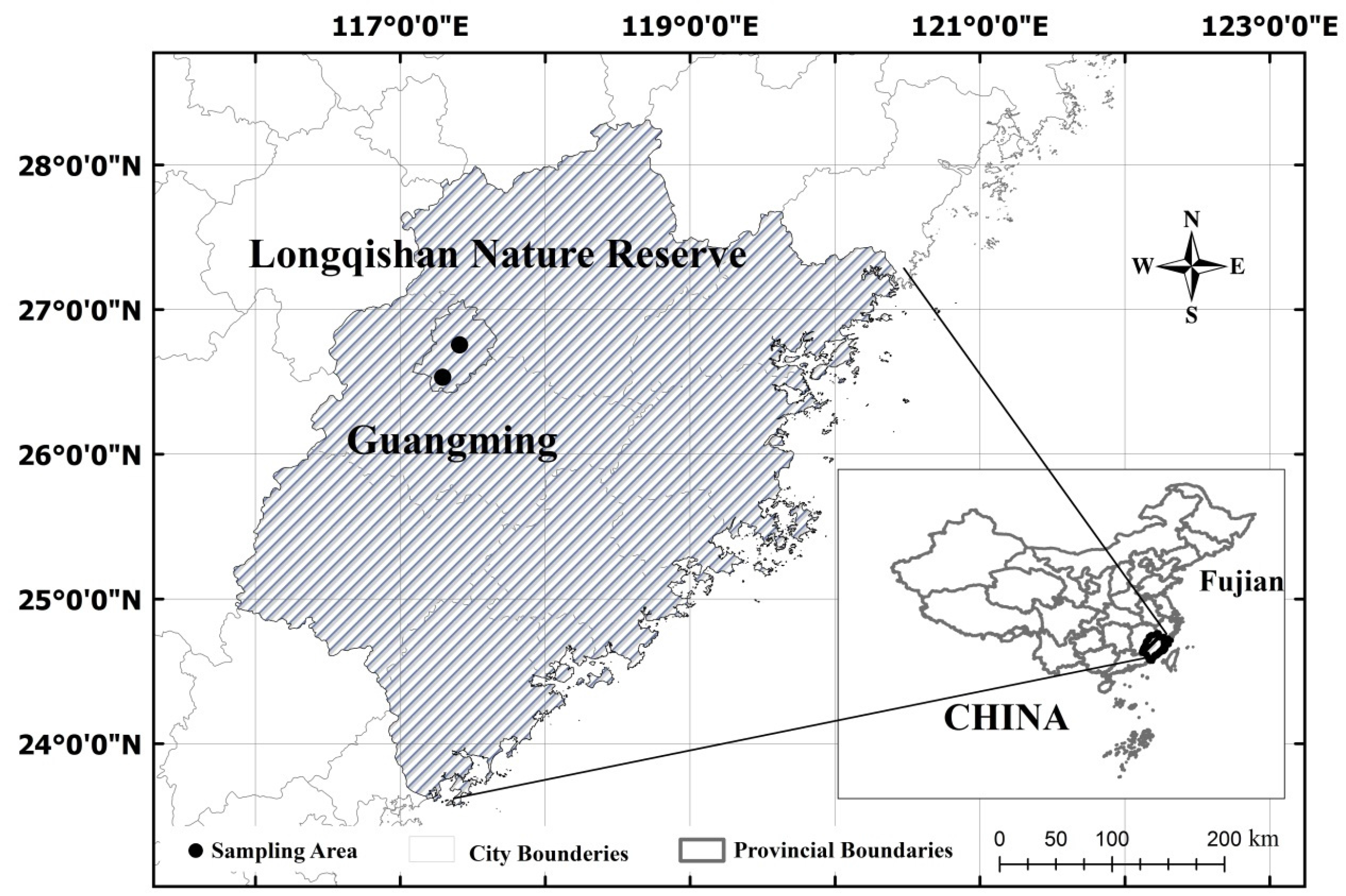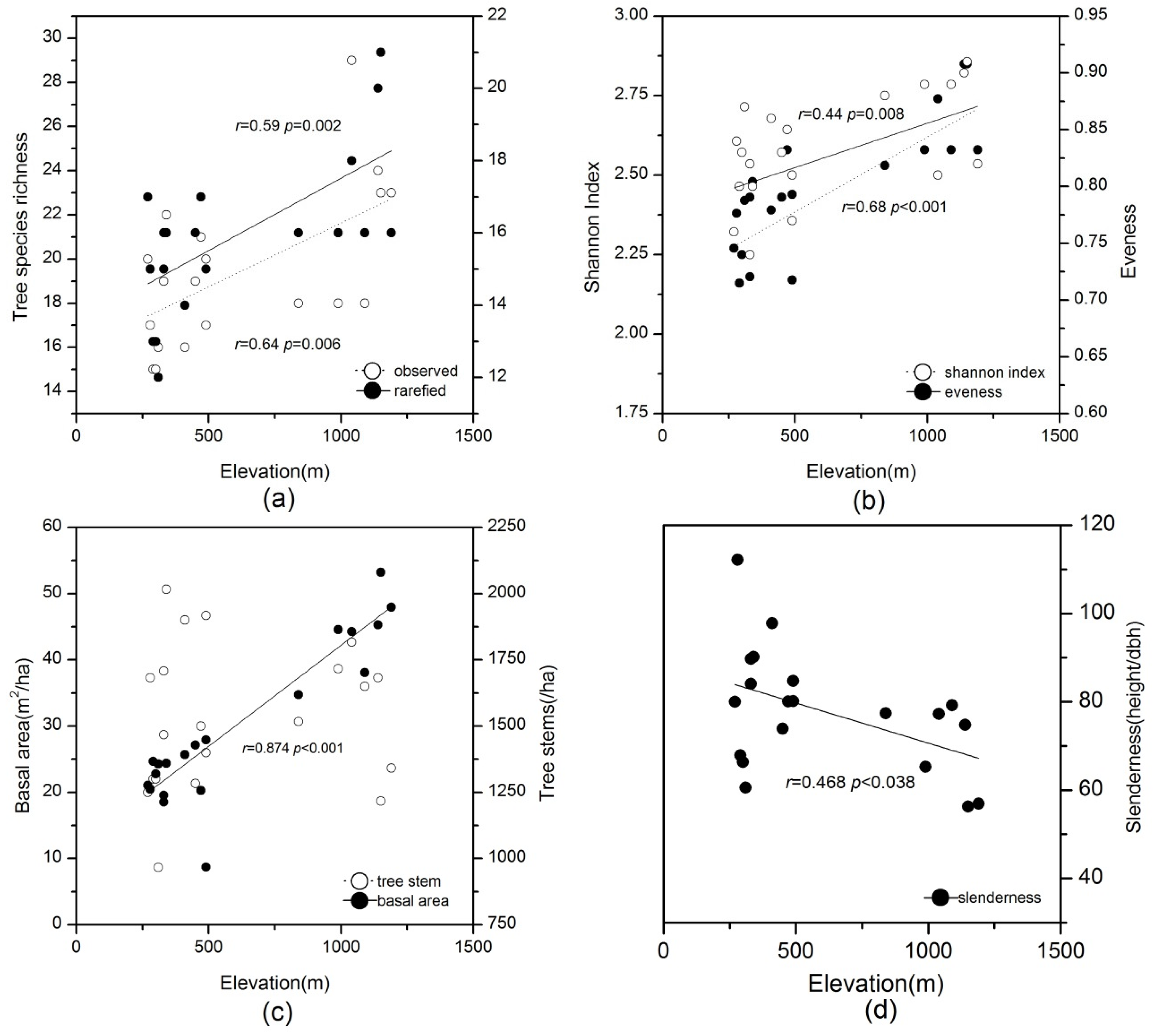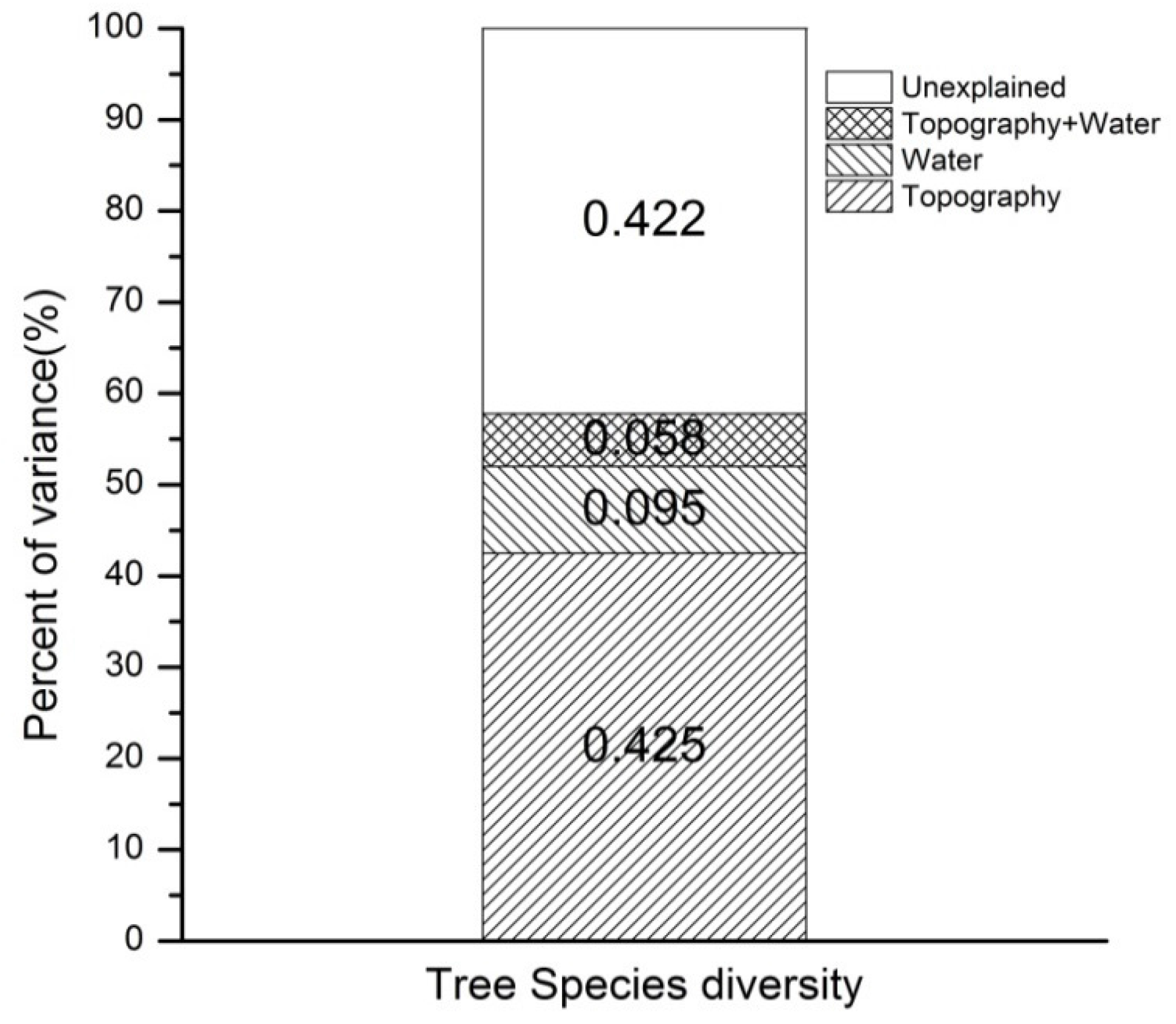Spatial Heterogeneity in Tree Diversity and Forest Structure of Evergreen Broadleaf Forests in Southern China along an Altitudinal Gradient
Abstract
:1. Introduction
2. Materials and Methods
2.1. Study Site
2.2. Study Design and Sample Collection
Tree Diversity, Stand Structure and Environmental Variables
3. Data Analysis
4. Results
4.1. Tree Diversity and Stand Structure as a Function of Altitude
4.2. Stand Structure and Species Diversity in Different Forest Types (A and B)
4.3. Variation of Topography and Water Conservation Capacity
4.4. Redundancy Analysis of Topography and Water on Species Diversity
4.5. Variation Partitioning of Topography and Water Conservation on Species Diversity
5. Discussion
5.1. Tree Diversity as a Function of Altitude
5.2. Stand Structure Variations
5.3. Environmental Variation and Tree Diversity
6. Conclusions
Acknowledgments
Author Contributions
Conflicts of Interest
References
- Whittaker, R.H. Vegetation of the Siskiyou mountains, Oregon and California. Ecol. Monogr. 1960, 30, 279–338. [Google Scholar] [CrossRef]
- MacArthur, R.H. Geographical Ecology: Patterns in the Distribution of Species; Princeton University Press: Princeton, NJ, USA, 1972. [Google Scholar]
- Walter, H.; Breckle, S. Ecological Systems of the Geobiosphere: 2 Tropical and Subtropical Zonobiomes; Springer Science & Business Media: New York, NY, USA, 2013; Volume 2. [Google Scholar]
- Givnish, T.J. Altitudinal gradients in tropical forest composition, structure, and diversity in the Sierra de Manantlán. J. Ecol. 1998, 86, 999–1020. [Google Scholar]
- Aiba, S.; Kitayama, K. Structure, composition and species diversity in an altitude-substrate matrix of rain forest tree communities on Mount Kinabalu, Borneo. Plant Ecol. 1999, 140, 139–157. [Google Scholar] [CrossRef]
- Baruch, Z. Ordination and classification of vegetation along an altitudinal gradient in the Venezuelan paramos. Vegetatio 1984, 55, 115–126. [Google Scholar]
- Whittaker, R.H.; Niering, W.A. Vegetation of the Santa Catalina Mountains, Arizona. V. Biomass, production, and diversity along the elevation gradient. Ecology 1975, 56, 771–790. [Google Scholar] [CrossRef]
- Lomolino, M. Elevation gradients of species-density: Historical and prospective views. Glob. Ecol. Biogeogr. 2001, 10, 3–13. [Google Scholar] [CrossRef]
- Peet, R.K. Forest vegetation of the Colorado Front Range: Patterns of species diversity. Vegetatio 1978, 37, 65–78. [Google Scholar] [CrossRef]
- Wilson, J.B.; Sykes, M.T. Some tests for niche limitation by examination of species diversity in the Dunedin area, New Zealand. N. Z. J. Bot. 1988, 26, 237–244. [Google Scholar] [CrossRef]
- Ovington, J.D. Ecosystems of the World 10. Temperate Broad-Leaved Evergreen Forests; Elsevier Science Publishers BV: Amsterdam, Netherlands, 1983. [Google Scholar]
- Fu, B.J.; Liu, S.L.; Ma, K.M.; Zhu, Y.G. Relationships between soil characteristics, topography and plant diversity in a heterogeneous deciduous broad-leaved forest near Beijing, China. Plant Soil 2004, 261, 47–54. [Google Scholar] [CrossRef]
- Edwards, P.J.; Grubb, P.J. Studies of mineral cycling in a montane rain forest in New Guinea: I. The distribution of organic matter in the vegetation and soil. J. Ecol. 1977, 65, 943–969. [Google Scholar] [CrossRef]
- Johnston, M.H. Soil-vegetation relationships in a tabonuco forest community in the Luquillo Mountains of Puerto Rico. J. Trop. Ecol. 1992, 8, 253–263. [Google Scholar] [CrossRef]
- Oliveira-Filho, A.D.; Curi, N.; Vilela, E.A.; Carvalho, D.D. Tree species distribution along soil catenas in a riverside semideciduous forest in southeastern Brazil. Flora Morphol. Geobot. Oekophysiol. 1997, 192, 47–64. [Google Scholar]
- Mangan, S.A.; Schnitzer, S.A.; Herre, E.A.; Mack, K.M.; Valencia, M.C.; Sanchez, E.I.; Bever, J.D. Negative plant-soil feedback predicts tree-species relative abundance in a tropical forest. Nature 2010, 466, 752–755. [Google Scholar] [CrossRef] [PubMed]
- Thuiller, W.; Lavorel, S.; Araújo, M.B.; Sykes, M.T.; Prentice, I.C. Climate change threats to plant diversity in Europe. Proc. Natl. Acad. Sci. USA 2005, 102, 8245–8250. [Google Scholar] [CrossRef] [PubMed]
- Ryan, M.G.; Stape, J.L.; Binkley, D.; Fonseca, S.; Loos, R.A.; Takahashi, E.N.; Silva, C.R.; Silva, S.R.; Hakamada, R.E.; Ferreira, J.M.; et al. Factors controlling Eucalyptus productivity: How water availability and stand structure alter production and carbon allocation. For. Ecol. Manag. 2010, 259, 1695–1703. [Google Scholar] [CrossRef]
- Xiong, S.; Johansson, M.E.; Hughes, F.M.; Hayes, A.; Richards, K.S.; Nilsson, C. Interactive effects of soil moisture, vegetation canopy, plant litter and seed addition on plant diversity in a wetland community. J. Ecol. 2003, 91, 976–986. [Google Scholar] [CrossRef]
- Borchert, R. Soil and stem water storage determine phenology and distribution of tropical dry forest trees. Ecology 1994, 75, 1437–1449. [Google Scholar] [CrossRef]
- Whittaker, R.H. Vegetation of the great smoky mountains. Ecol. Monogr. 1956, 26, 1–80. [Google Scholar] [CrossRef]
- Li, Z. Vegetation in Longqi Mountain; Science and Technology of China Press: Beijing, China, 1994. [Google Scholar]
- Wang, G.L.; Sun, Q.G. Characteristics of Subtropical Plants from Longqi Mountain, Fujian Province and Analysis of Ecological Value. J. Fujian Coll. For. 2002, 22, 376–380. [Google Scholar]
- He, J.; Chen, W.; Xie, Z.; Hu, D. Types of the evergreen broadleaf forest and their community species diversity in Longqishan Nature Reserve, Fujian Province. Chin. J. Ecol. 1998, 17, 2–7. [Google Scholar]
- Beers, T.W.; Dress, P.E.; Wensel, L.C. Notes and observations: Aspect transformation in site productivity research. J. For. 1966, 64, 691–692. [Google Scholar]
- Blake, G.R. Bulk density. In Methods of Soil Analysis. Part 1. Physical and Mineralogical Properties, Including Statistics of Measurement and Sampling; American Society of Agronomy: Guilford, NC, USA, 1965; pp. 374–390. [Google Scholar]
- Baver, L.D. Soil permeability in relation to non-capillary porosity. Soil Sci. Soc. Am. J. 1939, 3, 52–56. [Google Scholar] [CrossRef]
- Gardner, C.M.; Robinson, D.A.; Blyth, K.; Cooper, J.D. Soil water content. In Soil Analysis: Physical Methods; Soil Science Society of America: Madison, WI, USA, 2000; pp. 1–74. [Google Scholar]
- Greig-Smith, P. Quantitative Plant Ecology; University of California Press: Berkeley, CA, USA, 1983; Volume 9. [Google Scholar]
- Magurran, A.E. Ecological Diversity and Its Measurement; Springer Science & Business Media: New York, NY, USA, 2013. [Google Scholar]
- Gotelli, N.J.; Colwell, R.K. Quantifying biodiversity: Procedures and pitfalls in the measurement and comparison of species richness. Ecol. Lett. 2001, 4, 379–391. [Google Scholar] [CrossRef]
- Shannon, R.T. Revised effective ionic radii and systematic studies of interatomic distances in halides and chalcogenides. Acta Crystallogr. Sect. A 1976, 32, 751–767. [Google Scholar] [CrossRef]
- Pielou, E.C. An introduction to mathematical ecology. In An Introduction to Mathematical Ecology; Wiley-interscience: Hoboken, NJ, USA, 1969. [Google Scholar]
- Borcard, D.; Legendre, P.; Drapeau, P. Partialling out the spatial component of ecological variation. Ecology 1992, 73, 1045–1055. [Google Scholar] [CrossRef]
- Oksanen, J.; Kindt, R.; O Hara, B. Vegan: R functions for vegetation ecologists. Date Access 2005, 15, 2014. [Google Scholar]
- Shen, Z.; Hu, H.; Zhou, Y.; Fang, J. Altitudinal patterns of plant species diversity on the southern slope of Mt. Shennongjia, Hubei, China. Biodivers. Sci. 2004, 12, 99–107. [Google Scholar]
- Yu, M.; Hu, Z.; Yu, J.; Ding, B.; Fang, T. Forest vegetation types in Gutianshan Natural Reserve in Zhejiang. J. Zhejiang Univ. 2000, 27, 375–380. [Google Scholar]
- Fang, J.Y. Exploring altitudinal patterns of plant diversity of China’s mountains. Biodivers. Sci. 2004, 12, 1–212. [Google Scholar]
- Bhattarai, K.R.; Vetaas, O.R. Variation in plant species richness of different life forms along a subtropical elevation gradient in the Himalayas, east Nepal. Glob. Ecol. Biogeogr. 2003, 12, 327–340. [Google Scholar] [CrossRef]
- Liu, Y.; Zhang, Y.; He, D.; Cao, M.; Zhu, H. Climatic control of plant species richness along elevation gradients in the Longitudinal Range-Gorge Region. Chin. Sci. Bull. 2007, 52, 50–58. [Google Scholar] [CrossRef]
- Tang, C.Q.; Ohsawa, M. Zonal transition of evergreen, deciduous, and coniferous forests along the altitudinal gradient on a humid subtropical mountain, Mt. Emei, Sichuan, China. Plant Ecol. 1997, 133, 63–78. [Google Scholar] [CrossRef]
- Song, Y.; Zhang, K.; Liu, J.; Gu, Y.; Wang, X.; Hu, S. Evergreen broad-leaved forest community analysis of Wuyanling in Taishun country of Zhejiang province. Acta Phytoecol. Geobot. Sin. 1982, 1, 14–35. [Google Scholar]
- He, J.; Chen, W.; Li, L. Community diversity of the main types of the evergreen broad-leaved forest in the eastern part of the middle subtropical China. Acta Phytoecol. Sin. 1998, 22, 16–24. [Google Scholar]
- Lippok, D.; Beck, S.G.; Renison, D.; Hensen, I.; Apaza, A.E.; Schleuning, M. Topography and edge effects are more important than elevation as drivers of vegetation patterns in a neotropical montane forest. J. Veg. Sci. 2014, 25, 724–733. [Google Scholar] [CrossRef]
- Takyu, M.; Aiba, S.; Kitayama, K. Changes in biomass, productivity and decomposition along topographical gradients under different geological conditions in tropical lower montane forests on Mount Kinabalu, Borneo. Oecologia 2003, 134, 397–404. [Google Scholar] [CrossRef] [PubMed]
- Nanami, S.; Kawaguchi, H.; Tateno, R.; Li, C.; Katagiri, S. Sprouting traits and population structure of co-occurring Castanopsis species in an evergreen broad-leaved forest in southern China. Ecol. Res. 2004, 19, 341–348. [Google Scholar] [CrossRef]
- Homeier, J.; Breckle, S.W.; Günter, S.; Rollenbeck, R.T.; Leuschner, C. Tree Diversity, Forest Structure and Productivity along Altitudinal and Topographical Gradients in a Species-Rich Ecuadorian Montane Rain Forest. Biotropica 2010, 42, 140–148. [Google Scholar] [CrossRef]
- Acharya, B.K.; Chettri, B.; Vijayan, L. Distribution pattern of trees along an elevation gradient of Eastern Himalaya, India. Acta Oecol. 2011, 37, 329–336. [Google Scholar] [CrossRef]
- Parthasarathy, N. Changes in forest composition and structure in three sites of tropical evergreen forest around Sengaltheri, Western Ghats. Curr. Sci. India 2001, 80, 389–393. [Google Scholar]
- Kumar, A.; Marcot, B.G.; Saxena, A. Tree species diversity and distribution patterns in tropical forests of Garo Hills. Curr. Sci. 2006, 91, 1370–1381. [Google Scholar]
- Gentry, A.H. Changes in plant community diversity and floristic composition on environmental and geographical gradients. Ann. Mo. Bot. Gard. 1988, 75, 1–34. [Google Scholar] [CrossRef]
- O’Brien, E.M.; Field, R.; Whittaker, R.J. Climatic gradients in woody plant (tree and shrub) diversity: Water-energy dynamics, residual variation, and topography. Oikos 2000, 89, 588–600. [Google Scholar] [CrossRef]
- Knapp, A.K.; Fahnestock, J.T.; Hamburg, S.P.; Statland, L.B.; Seastedt, T.R.; Schimel, D.S. Landscape patterns in soil-plant water relations and primary production in tallgrass prairie. Ecology 1993, 74, 549–560. [Google Scholar] [CrossRef]
- Wolf, J.A.; Fricker, G.A.; Meyer, V.; Hubbell, S.P.; Gillespie, T.W.; Saatchi, S.S. Plant species richness is associated with canopy height and topography in a neotropical forest. Remote Sens. 2012, 4, 4010–4021. [Google Scholar] [CrossRef]
- Enoki, T. Microtopography and distribution of canopy trees in a subtropical evergreen broad-leaved forest in the northern part of Okinawa Island, Japan. Ecol. Res. 2003, 18, 103–113. [Google Scholar] [CrossRef]
- Legendre, P.; Mi, X.; Ren, H.; Ma, K.; Yu, M.; Sun, I.F.; He, F. Partitioning beta diversity in a subtropical broad-leaved forest of China. Ecology 2009, 90, 663–674. [Google Scholar] [CrossRef] [PubMed]
- Geris, J.; Tetzlaff, D.; McDonnell, J.; Soulsby, C. The relative role of soil type and tree cover on water storage and transmission in northern headwater catchments. Hydrol. Process. 2015, 29, 1844–1860. [Google Scholar] [CrossRef]
- Martinez-Fernandez, J.; Hernandez-Santana, V. Soil water reserve estimation and vegetation relationships in a Mediterranean sub-humid forested catchment. Hydrol. Res. 2012, 43, 167–178. [Google Scholar] [CrossRef]
- Wu, G.; Zhang, Z.; Wang, D.; Shi, Z.; Zhu, Y. Interactions of soil water content heterogeneity and species diversity patterns in semi-arid steppes on the Loess Plateau of China. J. Hydrol. 2014, 519, 1362–1367. [Google Scholar] [CrossRef]
- Wang, Z.; Hou, Y.; Fang, H.; Yu, D.; Zhang, M.; Xu, C.; Chen, M.; Sun, L. Effects of plant species diversity on soil conservation and stability in the secondary succession phases of a semihumid evergreen broadleaf forest in China. J. Soil Water Conserv. 2012, 67, 311–320. [Google Scholar] [CrossRef]
- Mathys, A.; Coops, N.C.; Waring, R.H. Soil water availability effects on the distribution of 20 tree species in western North America. For. Ecol. Manag. 2014, 313, 144–152. [Google Scholar] [CrossRef]
- Saxton, K.E.; Rawls, W.J.; Romberger, J.S.; Papendick, R.I. Estimating generalized soil-water characteristics from texture. Soil Sci. Soc. Am. J. 1986, 50, 1031–1036. [Google Scholar] [CrossRef]
- Saxton, K.E.; Rawls, W.J. Soil Water Characteristic Estimates by Texture and Organic Matter for Hydrologic Solutions. Soil Sci. Soc. Am. J. 2006, 70, 1569–1578. [Google Scholar] [CrossRef]
- Zhang, L.; Mi, X.; Shao, H.; Ma, K. Strong plant-soil associations in a heterogeneous subtropical broad-leaved forest. Plant Soil 2011, 347, 211–220. [Google Scholar] [CrossRef]
- Fleischbein, K.; Wilcke, W.; Goller, R.; Boy, J.; Valarezo, C.; Zech, W.; Knoblich, K. Rainfall interception in a lower montane forest in Ecuador: Effects of canopy properties. Hydrol. Process. 2005, 19, 1355–1371. [Google Scholar] [CrossRef]
- Tilman, D. Resource Competition and Community Structure; Princeton University Press: Princeton, NJ, USA, 1982. [Google Scholar]
- Holdridge, L.R. Determination of world plant formations from simple climatic data. Science 1947, 105, 267–268. [Google Scholar] [CrossRef] [PubMed]
- Silvertown, J. Plant coexistence and the niche. Trends Ecol. Evol. 2004, 19, 605–611. [Google Scholar] [CrossRef]
- Hubbell, S.P. The Unified Neutral Theory of Biodiversity and Biogeography (MPB-32); Princeton University Press: Princeton, NJ, USA, 2001; Volume 32. [Google Scholar]
- Whittaker, R.H. Dominance and Diversity in Land Plant Communities Numerical relations of species express the importance of competition in community function and evolution. Science 1965, 147, 250–260. [Google Scholar] [CrossRef] [PubMed]
- Warner, R.R.; Chesson, P.L. Coexistence mediated by recruitment fluctuations: A field guide to the storage effect. Am. Nat. 1985, 125, 769–787. [Google Scholar] [CrossRef]
- Mittelbach, G.G.; Schemske, D.W.; Cornell, H.V.; Allen, A.P.; Brown, J.M.; Bush, M.B.; Harrison, S.P.; Hurlbert, A.H.; Knowlton, N.; Lessios, H.A. Evolution and the latitudinal diversity gradient: Speciation, extinction and biogeography. Ecol. Lett. 2007, 10, 315–331. [Google Scholar] [CrossRef] [PubMed]
- Harrison, S.; Cornell, H. Toward a better understanding of the regional causes of local community richness. Ecol. Lett. 2008, 11, 969–979. [Google Scholar] [CrossRef] [PubMed]




| Stand Structure | Type A (Means ± S.E.) | Type B (Means ± S.E.) |
|---|---|---|
| Tree species richness (/600 m2) (plots, dbh ≥ 5 cm) | 18.15 ± 2.30 | 21.85 ± 4.14 |
| Species diversity (rarefied to per N = 59 trees; /600 m2) (plots, dbh ≥ 5 cm) | 14.92 ± 1.55 | 17.57 ± 2.15 |
| Shannon diversity (plots, dbh ≥ 5 cm) | 2.35 ± 0.13 | 2.67 ± 0.14 |
| Shannon evenness (plots, dbh ≥ 5 cm) | 0.81 ± 0.39 | 0.87 ± 0.40 |
| Slenderness (height/dbh) (plots, dbh ≥ 5 cm) | 76.31 ± 14.08 | 80.38 ± 13.73 |
| Average dbh (cm) (plots, dbh ≥ 5 cm) | 11.58 ± 1.71 | 15.58 ± 2.37 |
| Average height (m) (plots, dbh ≥ 5 cm) | 9.38 ± 1.34 | 10.66 ± 0.55 |
| Basal area (m2) (plots, dbh ≥ 5 cm; /ha) | 21.96 ± 4.96 | 44.01 ± 6.11 |
| Tree stem number (/ha) (plots, dbh ≥ 5 cm) | 1514.77 ± 310.89 | 1563.30 ± 216.36 |
© 2016 by the authors; licensee MDPI, Basel, Switzerland. This article is an open access article distributed under the terms and conditions of the Creative Commons Attribution (CC-BY) license (http://creativecommons.org/licenses/by/4.0/).
Share and Cite
Cui, W.; Zheng, X.-X. Spatial Heterogeneity in Tree Diversity and Forest Structure of Evergreen Broadleaf Forests in Southern China along an Altitudinal Gradient. Forests 2016, 7, 216. https://doi.org/10.3390/f7100216
Cui W, Zheng X-X. Spatial Heterogeneity in Tree Diversity and Forest Structure of Evergreen Broadleaf Forests in Southern China along an Altitudinal Gradient. Forests. 2016; 7(10):216. https://doi.org/10.3390/f7100216
Chicago/Turabian StyleCui, Wei, and Xiao-Xian Zheng. 2016. "Spatial Heterogeneity in Tree Diversity and Forest Structure of Evergreen Broadleaf Forests in Southern China along an Altitudinal Gradient" Forests 7, no. 10: 216. https://doi.org/10.3390/f7100216
APA StyleCui, W., & Zheng, X.-X. (2016). Spatial Heterogeneity in Tree Diversity and Forest Structure of Evergreen Broadleaf Forests in Southern China along an Altitudinal Gradient. Forests, 7(10), 216. https://doi.org/10.3390/f7100216






